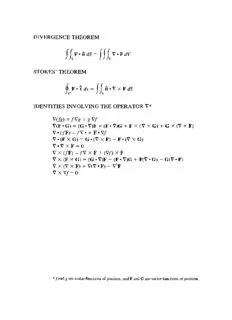
Div, Grad, Curl, and All That: An Informal Text on Vector Calculus, Fourth Edition PDF
Preview Div, Grad, Curl, and All That: An Informal Text on Vector Calculus, Fourth Edition
DIVERGENCE THEOREM [frsnss- [ff vera STOKES’ THEOREM firctacs[farrscras IDENTITIES INVOLVING THE OPERATOR V+ VOR) = 198 | E+ G) ps V)K + (FVG + FX (Vx G)+G x (FX PF) VefR) f0 et Bf Ve(PX G)— GPX FL F(T XG) FeUxF=0 VX UP) -f¥ XP LX FE TX xG) DE - (FG + FFG) - GD FX (Fx EB) = VFB) — OP Vx Ho Fan gave scale Foeecions of positon, aed F and C ure vector functions of position. div, grad, curi, and all that fourth edition div, grad, an informal text h. m. schey curl, and all that on vector calculus fourth edition tt W-W-NORTON & COMPANY, New York + London ‘W.A¥, Norton & Company has becn independent since its founding in 1923, when William Warder Norton and Mary D, Herter Norton first published Joctures delivered at the Poople’s Institute, the adult education division of New York City's Cooper Union, The Nertons soon expanded their program beyond the Tnstitnte, publishing books by celebrated academics from America and abroad. By mid-century, the tic major pillars of Nortoa’s publishing program—trade books and college texls—were firmly eslsblshed. Tn the 1950s, the Norton faery transferred control of the ompany 10 ity employees, aul (oday—with a stalf of four hundred and a vomparable nurner of trade, college, and professional filles published each year—W.W. Norian & Company stands as te largest and oldest publishing house owned wholly hy ils employees. Copyright © 2005, 1997, 1999, 1973 by W.W. Norton & ‘Company. Lee. All sights reserved Printed inthe United States of America Composition by GGS Book Services, Auantic Highlands Library of Congross Cxtuloging-in-Putlication Data Schey, 11M, (Flacry Morte}, £930— Dis, grad, curl, and all that: yn informal text on vector saleulas / HIM, Schey.—ath ed, poem, Includes inden. 1. Vector analysis. {, Title (QA433.828 2008 S1S1.63—de22 2008053199 ISBN 0-393-92516-1 (pbk) W, W. Norton & Company, Inc, 500 Fifth Avenue. New York, N.Y. 10110 wae. wwnonton.cor W.W. Norton & Company Liu, Castle House, 75/76 Wells Stret, London WIT 30 234567890 Zusammengestohlen sus Verschiedenem diesem und jonera, Leuivig van Beethoven Contents Preface to the Fourth Edition Chapter £ Introduction, Vector Functions, and Electrostatics Introdus Vector Functions Electrostaties Problems Chupter ff Surface Integrals and the Divergence Gauss! Law ‘The Unit Normal Vector Definition of Surface Integrals Bvatuating Surface Integrals Flux Using Gauss’ Law to Find the Field ‘The Divergence ‘The Divergence in Cylindrical and Spherical Coordinates The Del Notation ‘The Divergence Theorem ‘Two Simple Applications of the Divergence Theorem Problems ix a 32 Chapter HE Line Integrals and the Curl ‘Work and I.ine Integrals Line Integrals Involving Vector Functions Path Independence The Corl ‘The Curl in Cylindrical and Spherical Coordinates ‘The Meaning of the Curl Differential Form of the Circulation Law Stokes' Theorem An Application of Stokes’ Theorem Stokes’ Theorem and Simply Connected Regions Path Independence and the Curl Problems Chapter TV The Gradient Line Integeals and the Gradient Finding the Electrostatic Field Using Laplace's Equation Directional Derivatives and the Gradient Geometric Significance of the Gradient ‘The Gradient in Cylindrical and Spherical Coordinates Problems Solutions to Problems Preface to the Fourth Edition Can we ever huve tow much of gund thing? Miguel de Cervantes This new edition differs from the Third in two major respects. First, a number of new worked examples have been added. This, has been done in response ro the comments of many students that such exaraples would be an aid in understanding the material and useful in preparing them to do the problem sets. My task was to add enough examples to be helpful, without at the same Gime lengthening the text significantly. (Two reviewers urged me not t0 lengthen the hook at all, inadvertently providing an answer to Sr, de Cervantes’ question.) ‘The second major difference between this edition and its prede- cessar involves switching the roles of the to spherical angles 8 and ¢, Yeurs ago, when the book was written it was common to use @ as the polar angle and & as the azimuthal, Nowadays. the ‘more common convention reverses this. making @ the azirmuelal angle and & the polar the convention we adopt in this edition, I wish to dank the many readers who, over the years, have ‘written me with suggestions for improvements in the text, These suggestions have often been adopted and have been an important ‘eason for the book’s very long liletime.
